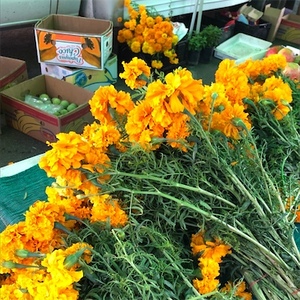


Calendula Flowers
Estimated Inventory, ea : 8.00
This item was last sold on : 08/01/25
| Fresh Origins | Homepage |
Description/Taste
Calendula flowers generally produce large heads, averaging 5 to 7 centimeters in diameter, and the petals are arranged in a circular formation around a central point. Calendula blossoms are composite flowers, meaning the flower head is comprised of ray florets and disc florets. Ray florets are the longer, elongated, straight, and flat petals that develop on the outer portion of the head. These petals appear in several different hues, ranging from bright yellow, orange to orange-red, and have a soft, delicate, and tender nature. The center of the bloom is composed of disc florets, tiny individual petals that appear in shades of dark purple, brown, red, yellow, or orange. Calendula flowers can produce blooms with single, double, or multi-layered rows of ray florets, and each variety will differ in color and appearance. The flowers are connected to upright, fleshy green stems by green bracts that often contain a sticky resin, valued in medicinal practices. Calendula flowers open in the morning and follow the sun, closing in the afternoon. The flowers release a subtly woody, musky, and spice-like aroma reminiscent of a combination of sandalwood musk and tree sap. Calendula flowers and leaves are edible, and the leaves contain a bitter, vegetal taste similar to dandelion greens. The flowers have a mild, slightly bitter, tangy, herbal, and peppery flavor.
Seasons/Availability
Calendula flowers can be planted year-round in some temperate regions. In most climates, the flower’s peak blooming season occurs in the summer through late fall.
Current Facts
Calendula flowers, botanically classified as Calendula officinalis, are a general descriptor for a genus of colorful flowers belonging to the Asteraceae or daisy family. The Calendula genus encompasses at least 15 to 20 different species of flowers, and the plants can be grown as a perennial in warmer climates and an annual in cooler regions. Calendula flowers form at the end of upright stems that can reach 20 to 75 centimeters in height, and it takes approximately 6 to 8 weeks after sowing for the flowers to bloom. The blossoms are sometimes called Pot Marigold or simply Marigold due to their similar appearance to the ruffled, golden plant. Still, it is important to note that Calendula blossoms are distinct and should not be used interchangeably with marigold species. Calendula flowers are ancient plants that have been harvested from the wild, cultivated, and hybridized over time for use in culinary, medicinal, and religious practices. In the modern-day, there are several commercial varieties favored as ornamental in home garden landscapes, known under names such as Pacific Beauty, Golden Princess, Kabloona, Neon, Citrus Cocktail, Dwarf Germ, Pink Surprise, and Sherbet Fizz.
Nutritional Value
Calendula flowers are a source of vitamin C to strengthen the immune system, vitamin A to maintain healthy organ functioning, and other antioxidants to reduce inflammation and protect the cells against free radical damage. The flowers also provide vitamins D, E, and B, anti-inflammatory, and antiseptic properties, incorporated into lotions, creams, and balms for topical applications. Calendula blossoms were used throughout Europe as a soothing aid for wounds, burns, and skin irritations. The petals were also steeped in tea to reduce inflammation within the throat and digestive tract, and they were mixed with vinegar as a scalp treatment. In Traditional Chinese Medicine, Calendula petals were used to increase blood flow and detox wounds.
Applications
Calendula flowers have a mild, herbal, and slightly tangy, bitter flavor suited for fresh and cooked preparations. The petals should be removed from the bracts before use and can be scattered whole across salads, grain bowls, and fruit platters. Calendula blossoms add flavor and color to dishes and can be chopped into salsa, incorporated into dressings, or frozen into ice cubes as a festive element in beverages. In addition to fresh preparations, Calendula flowers can be cooked into egg-based dishes such as quiche, scrambled eggs, and frittatas, simmered into sauces, mixed into pasta, or sprinkled over pizza. The colorful petals add a golden tint to curries, soups, and stews and were once called “poor man’s saffron” as they were used to add pigment to main dishes, butter, and cheeses. Calendula flowers can also color sorbets, cake batters, frosting, and rice dishes, including paella. The tangy nature of the petals can be served with sweeter ingredients in desserts to develop complex flavorings or steeped into herbal tea blends. Calendula flowers pair well with tropical fruits such as bananas, coconut, and pineapple, blueberries, strawberries, citrus, vanilla, honey, maple syrup, and herbs such as thyme, sage, and rosemary. Calendula flowers should be used immediately for the best quality and flavor. Fresh blooms will keep for a couple of days when stored in a container in the refrigerator. The flowers can also be dried and kept in a sealed container away from direct sunlight for one year.
Ethnic/Cultural Info
Throughout Europe and Asia, Calendula flowers were thought to contain magical properties to offer clarity and protection. The flowers were traditionally scattered below beds as protection from evil, and some cultures believed the blooms would bring clarity to dreams for unresolved conflicts. Calendula blossoms were also hung in doorways and worn-in coat pockets as protection against robbers. The flower’s brightly colored nature connected the blooms with cheerful energy and was thought to help comfort the mind and heart, improving outward appearances. One European legend was the flower’s ability to help a woman choose her suitor. It was said if an unmarried woman had two potential suitors, consuming a mixture of white wine, Calendula, wormwood, thyme, honey, and marjoram in a ritual would reveal her true match. While it is unknown if these rituals were widely practiced, it was once common for Europeans to scatter the orange and yellow petals in baths to improve mood and nourish the skin.
Geography/History
Calendula flowers are native to regions surrounding the Mediterranean, including southern Europe, Egypt, and portions of western Asia. The flowers have been found growing wild since ancient times and were believed to have been cultivated and hybridized over time to create the varieties that are sown in home gardens in the modern-day. Calendula was recorded in early medicinal texts and was known by historians to have been used in Ancient Greek and Roman empires. The flowers were also planted in French gardens by the 5th century and were cultivated in England around the 13th century. Calendula blossoms grow wild along roadsides, in disturbed areas, near settlements, and on forest edges. The flowers are also planted as ornamental in home gardens worldwide. The flowers were introduced to the New World with European colonists, and in Europe and the United States, the petals were often incorporated into medicinal practices during the 19th century to slow bleeding and encourage healing. Today Calendula flowers have been naturalized worldwide and are planted in home gardens as a colorful bloom. The flowers are sold fresh through local farmers markets and distributors and dried through tea shops, specialty retailers, and online companies.
Featured Restaurants
Restaurants currently purchasing this product as an ingredient for their menu.
| Jeune Et Jolie | Carlsbad CA | 858-231-0862 |
| Machete Coffee | National City CA | 858-336-5390 |
| Polite Provisions | San Diego CA | 619-677-3784 |
| Estancia Adobe | San Diego CA | 858-550-1000 |
Recipe Ideas
Recipes that include Calendula Flowers. One




 Learn More...
Learn More...











